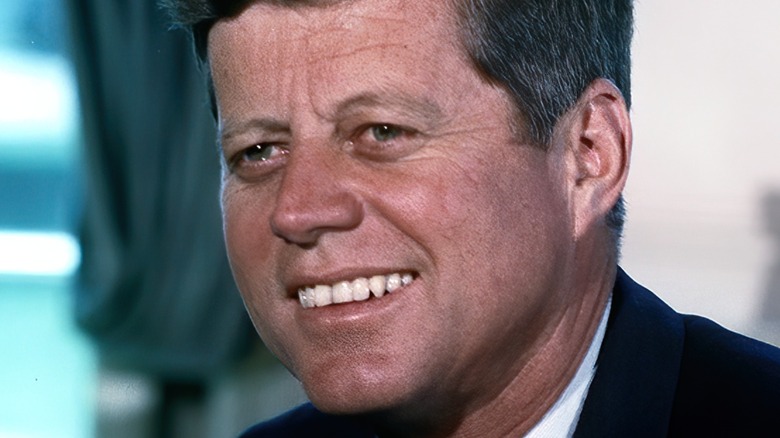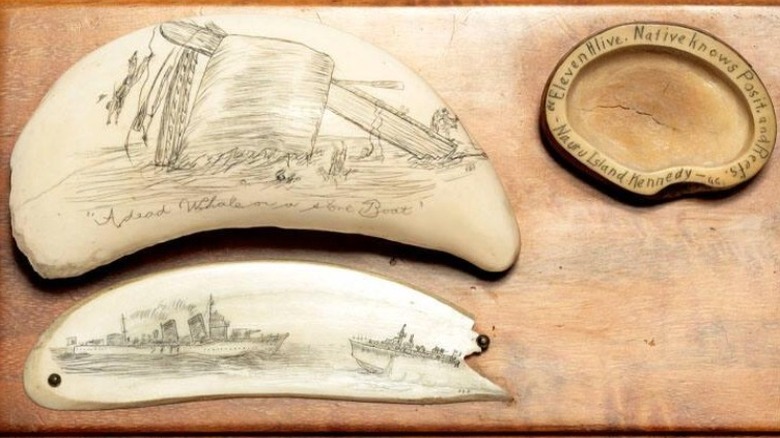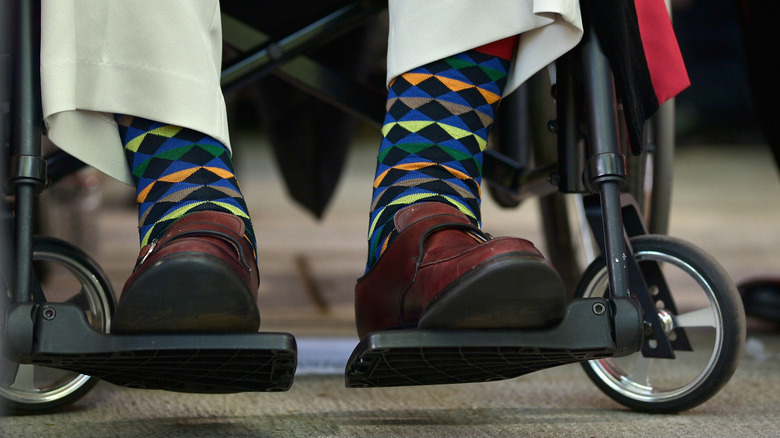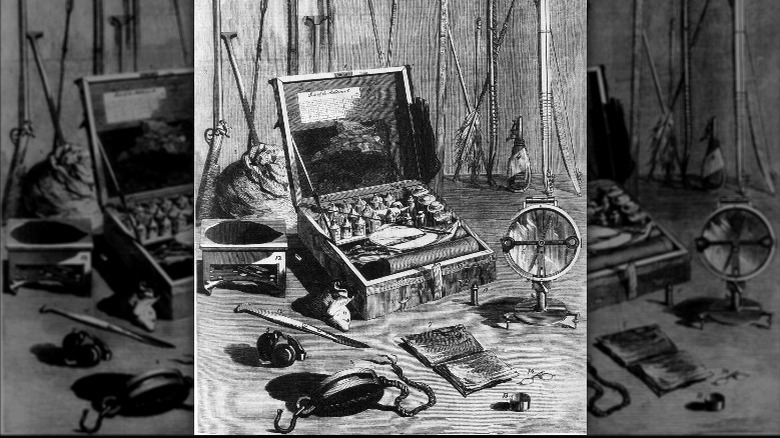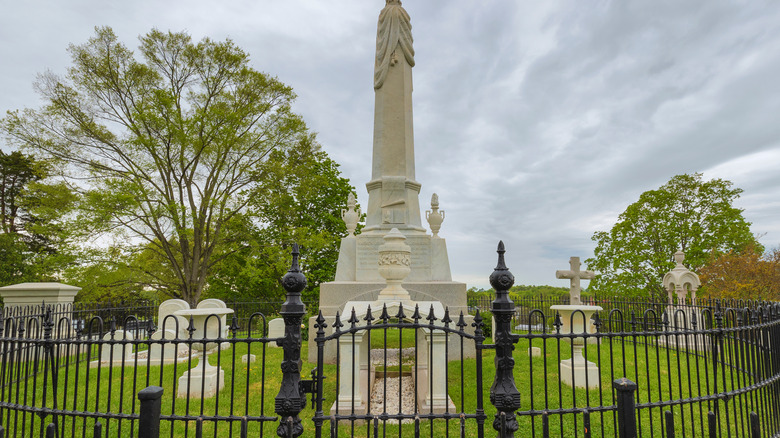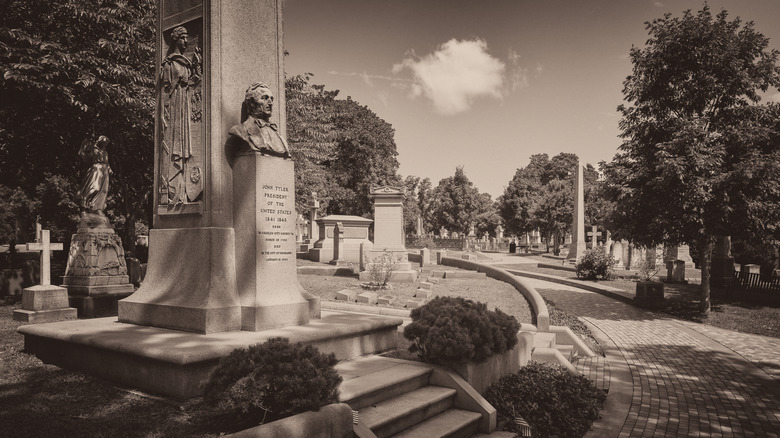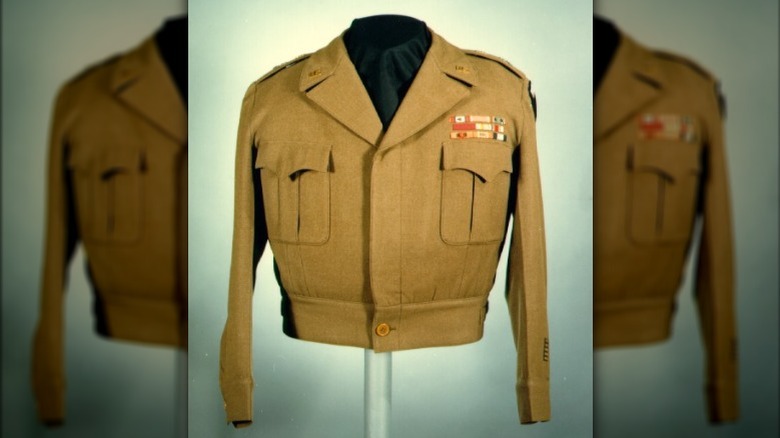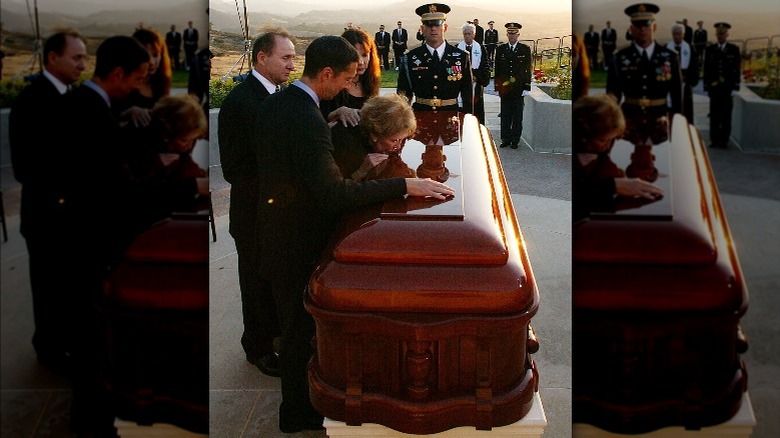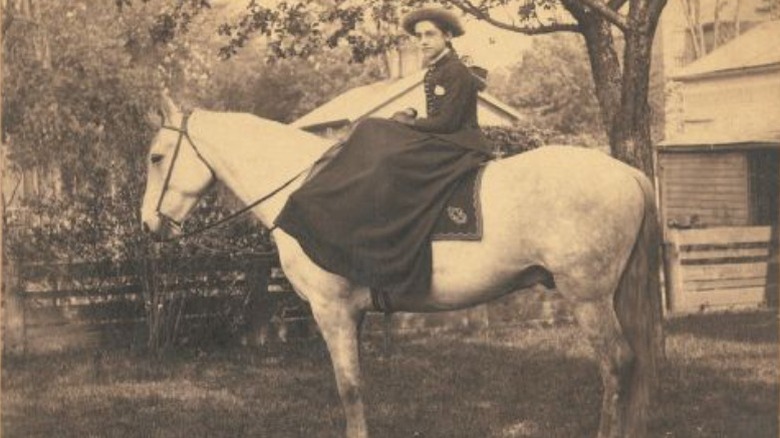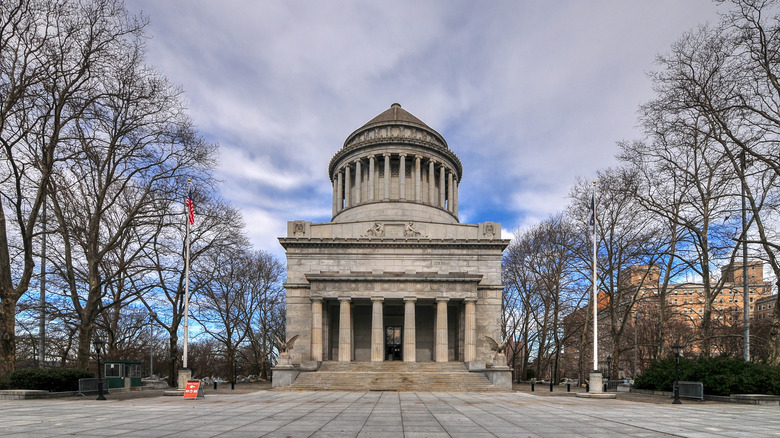Things American Presidents Were Buried With
Once someone becomes president, their life is, in many ways, an open book. There are documentaries filmed and biographies written about them by the dozens. They (usually) release their taxes for the world to see. They are constantly accompanied, even in private moments, by members of the Secret Service for the rest of their lives. They give interviews where they open up about themselves, and people from their past spill secrets about them to the tabloids.
But for all that we can know about presidents, especially the more modern ones, one area of their lives – or deaths, as it were – seems shrouded in an unexpected amount of privacy. While many people choose to take sentimental or otherwise important items with them to their graves, if most presidents also chose to do this, that information has not been made public. Now, it's possible that most presidents simply did not share their coffins with family photos or letters from loved ones or stuff they nicked from the White House. Or it might be that after very public lives, they, or their families, just decided that something as emotional as taking items to the grave deserved to be kept private.
Whatever the reason, this lack of information just makes the details we do know about all the more interesting. Whether it's what a late president wore to his own funeral, items placed in or on their coffins, or even the coffins themselves, here are some of the things American presidents were buried with.
John F. Kennedy
Of all the presidents, the items that John F. Kennedy took to the grave with him seem to be the most well-documented. This might simply be because his death was so tragic and unexpected, with the country plunged into unimaginable grief after the tragedy, that every part of the young president's funeral was newsworthy.
It would remain so long after he'd actually been laid to rest, as well. In a 1996 interview (via The Seattle Times), Joe Hagan, the mortician who was in charge of JFK's body after its journey from Dallas, autopsy, and embalming, said he got asked about funeral details all the time – unfortunately, often by conspiracy theorists. But while he couldn't help them out by offering up any weird details, he did know exactly what the president was buried with.
According to Hagan, the Catholic JFK was buried with a rosary and three letters from family members. He was also wearing gold cufflinks, as well as a PT-109 tie clip – that being the small boat he was on that sank during an encounter with the Japanese in 1943. But the most notable item was slipped into JFK's mahogany casket by his widow, Jackie: a piece of scrimshaw. Also connected to his time in the Navy, as scrimshaw was originally art created by men on whaling ships made to pass the time, per Boston Magazine, JKF had his own collection of the intricately carved bones. His favorite, the one he took to his grave, bore an etching of the presidential seal and had been a Christmas gift from his wife the year before.
George H.W. Bush
While it's impossible to ignore the sexual harassment allegations that emerged in his later years, Bush Sr. also got a bit of notoriety in his old age for one specific style choice: his socks. Once he was confined to a wheelchair for most of his public appearances, his pants rode up enough to show quite a bit of sock, and H.W. embraced this. He always seemed to be wearing fun socks, not the bland black or brown you might expect from a former president in a suit.
His fun socks became so well-known, the GOP even launched a line of striped ones as a fundraising operation. Bush noted in the email (via USA Today), "I'm a self-proclaimed sock man. The louder, the brighter, the crazier the pattern – the better."
He even wore interesting socks to his wife's funeral in 2018, less than a year before he also passed away, per Business Insider: They were book-themed, as Barbara Bush's signature initiative was tackling illiteracy. So you know that being dead was not going to stop Bush Sr. from indulging in his favorite fashion trend. As his spokesperson tweeted before the president's funeral, "The 41st President will be carried to his final rest wearing socks that pay tribute to his lifetime of service, starting as an 18-year-old naval aviator in war." This made them sound a bit more serious than the accompanying image, which showed socks with cartoon fighter planes flying in formation. Despite the fact they would be outlandish for any other president to be laid to rest in, for George H.W. Bush, they were almost a bit boring.
Abraham Lincoln
So many aspects of Abraham Lincoln's funeral were abnormal. For one, he technically had about a dozen funerals, as The Washington Post explains, because as his body traveled by train from Washington, D.C. to Illinois, it was removed at various stops to allow hundreds of thousands of people to pay their respects. He was also embalmed, something that had only become slightly more common a few years before. In fact, it was all those people seeing his embalmed corpse that skyrocketed the procedure in popularity.
Lincoln was buried in a suit with some significance: He'd also worn it when he was sworn in as president for the second time just weeks before he was assassinated. Given the monumental time in which he lived and led the country, there are any number of items that could have gone to the grave with Lincoln that would have made sense. But given an infinite number of guesses, you would still never land on what actually did, the story is that bizarre.
At the time, the New York Herald reported that Captain Parker Snow, who had gone searching for the lost Franklin Expedition in the Arctic (guided by psychic visions), offered those in charge of Lincoln's funeral items he had believed to be from the doomed men (pictured), including a page from a Prayer Book and bits of uniform. According to a blog post by Russell Potter, an expert on the Franklin Expedition and editor of a book of the expedition's letters, it's not clear why in the world anyone would have agreed to bury them with Lincoln, but according to reports, those in charge did so.
Andrew Johnson
Andrew Johnson became president after Abraham Lincoln was assassinated, and as you might remember from your high school history class, his time as the top guy was pretty much a disaster. When President Donald Trump was being impeached (take your pick of which time), Johnson's name was in the news again as the U.S. got a refresher in the history of the process. Johnson was the first president ever to face an impeachment trial, and came very, very close to becoming the first president removed from office, being saved in the Senate by just one vote, according to the National Parks Service. It was actually the second time Congress had attempted to get him out of office, but the first attempt at impeachment didn't pass the House.
Despite his disastrous tenure in the White House, Johnson loved his country in his own way. He didn't even let losing the Republican nomination for president in 1868 stop him from continuing in politics, and he became a U.S. senator in 1875. His triumphant return to Washington, D.C. was extremely short-lived, however, as he died that same year.
His death was just another opportunity for Johnson to drive home just how much his country meant to him. Or maybe he just wanted to stick it to all those political rivals who had tried to throw him out of office. The former president chose to be buried literally wrapped in the American flag inside his coffin, with a copy of the U.S. Constitution as his pillow, per The Washington Post.
John Tyler
John Tyler is one of those one-term presidents from shortly before the Civil War whose names kind of get lost in the shuffle of the layman's limited presidential memory bank. In a 2019 book ranking the first 43 presidents, historians listed him as the fifth worst one. But for one reason, John Tyler should be much, much more well-known: He was the only U.S. president to die and be buried in the Confederacy.
According to the National Portrait Gallery's publication "America's Presidents," once he wasn't in charge of the country anymore, Tyler, a Virginia native, openly supported splitting it up. Then, when the South seceded, he served in the Confederate House of Representatives. Or rather, he was elected to serve but died before he could take his seat, as "The Presidents Fact Book" explains.
Having a former U.S. president who not only sided with their cause but chose to live and die in the South was a coup within a rebellion that the Confederate government was quick to take advantage of, according to "Embattled Capital: A Guide to Richmond During the Civil War." His funeral was a major event there, while at the same time virtually ignored by the North, who now considered Tyler a traitor. "Last Rites: The Evolution of the American Funeral" explains that in those days, the richest and most important people often covered their coffins in cloth. Lincoln's, for example, would be completely covered in black broadcloth before burial only a few years later. Tyler's coffin was also covered in cloth, a choice that would tie him to the traitorous rebellion forever: He was buried with his coffin wrapped in a Confederate flag.
Dwight D. Eisenhower
While Dwight D. Eisenhower is a well-known president, even for those who don't have all their names memorized, he's even more notable as the Allied commander in Europe during World War II.
For many, Ike would always be a military man first and a politician second. The choices he made surrounding aspects of his funeral and burial reflect that he felt the same way. But despite rising to the very top of the ranks as a five-star general, per The Washington Post, Eisenhower didn't want to be buried as a military leader, but as a common soldier. While he did get a large funeral service at Washington National Cathedral, something he probably couldn't get out of even if he wanted to, almost everything else about his funeral was modestly themed.
Rather than being buried in a general's uniform, Eisenhower had requested the look he'd made so famous in images of him during WWII, including the "Ike Jacket" (pictured). Nor did he go to his grave wearing all his many, many medals, instead picking just three, according to the Eisenhower Presidential Library: the Army Distinguished Service Medal, the Navy Distinguished Service Medal, and the Legion of Merit. And when it came to his coffin, he eschewed the fancy mahogany of other presidents, instead asking specifically for the $80 casket that was standard issue to regular soldiers. (However, probably out of concern for graverobbing, it was modified slightly with a glass seal, which slightly more than doubled the cost.) He was then buried in his hometown in Kansas.
Ronald Reagan and others
If a president wants to go into the ground in a style more in keeping with their status as the former leader of the Free World, and money is no object, there is just one company they turn to: The Marsellus Casket Company of Syracuse, New York.
Or at least, they could have for 131 years, up until the company closed down in 2003, as The New York Times reported at the time. Still, there were plenty of U.S. presidents who died during that period, and lots of them opted for a coffin from the storied company. In fact, according to the Casket and Funeral Supply Association of America, Marsellus even had a coffin model M710 known as the "President Mahogany." It's no surprise then that presidents John F. Kennedy and Richard Nixon, as well as their first ladies Jackie Kennedy and Pat Nixon, were buried in this model. (Other politicians, including two senators and a vice president, chose it as well, along with a who's-who of famous and/or rich people.)
Harry S. Truman was buried in a slight variation, the M720 Mahogany, while Ronald Reagan selected the M700 Masterpiece Mahogany (pictured). Their wives, Bess and Nancy, were similarly buried in the same caskets as their husbands. As you can see, these are no plain boxes, but pieces of art that then get put in the ground forever. And very expensive pieces of art, at that, as even before any modifications needed for a presidential coffin, they retail in the $20,000-40,000 range.
Rutherford B. Hayes
Calling what Rutherford. B. Hayes chose to be buried alongside a "thing" is rather unfair, especially if you are an animal lover. That's because it was, well, an animal. More than one, actually. You could probably make an argument that, really, Hayes and his wife are buried in a pet cemetery (the not-evil kind) at their estate in Ohio, since they are outnumbered by the graves of the pets that surround them.
The Rutherford B. Hayes Presidential Library and Museums shared in a Facebook post that one of the pets was a horse named Old Ned. He lived to be 36 years old, before dying in 1871. He was owned by Hayes but used as a buggy horse by his uncle, before eventually retiring for the last decade or so of his life. His grave is just behind the president's, and Old Ned's headstone is a small boulder with his name and dates etched in it.
On the library's website, they also mention a horse named Old Whitey (pictured), who was part of Hayes' Civil War campaigns, where his bright coloring made him a target for Confederate bullets. But he survived the war and became a favorite pet of Hayes. The president loved the horse so much, he actually received a telegram at the White House in 1879, informing him Old Whitey was about to meet his maker (also per the Hayes Presidential Library). The horse is also buried next to Hayes, along with the president's greyhound, Grim, who became a celebrity during his time in the White House.
Ulysses S. Grant
Okay, yes, fine. If it's a bit of a stretch to call an animal a "thing," then calling an actual human woman that is really unacceptable. But it's a story worth telling, since President Ulysses S. Grant's insistence on being buried with his wife completely changed his gravesite plans and would result in the construction of an iconic New York landmark.
Being buried with one's spouse is not a strange request in the slightest, and that includes the men who have been president of the U.S. Most presidents, it seems, have been buried with or next to their wives. But Julia Grant was not welcome at the location the former president originally wanted, West Point (per The New York Daily News). The problem was, the former first lady didn't fit the criteria for burial at the military academy, and, for some reason, they weren't willing to bend the rules for the former president and undisputed victor of the Civil War. But Ulysses wanted to spend eternity next to his very beloved wife more than he wanted to be buried at a place that meant so much to him, so West Point was out.
In the end, a plot of land in New York City was selected and a massive mausoleum was eventually built there, which is to this day the largest one in North America, according to Erenow. The former president had to wait quite a while for his wife to join him, though, as she outlived him by 17 years. However, she was eventually laid to rest beside him in Grant's Tomb.
